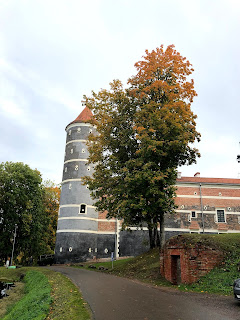On a hill outside the city of Šiauliai in northern Lithuania are two hundred thousand crosses, ranging from several metres high, to tiny crucifixes and rosaries. Their story is a complex mix of pagan tradition and Christian identity, anti-Soviet resistance and Catholic emancipation. It's a place of pilgrimage and a stop on the tour bus routes.
 Myths and legends about the hill have obscured the true story, but it's thought there have been crosses here since the fourteenth century. They were added to over the years, as symbols of faith, commemoration, or thanksgiving. During the Soviet era anyone planting a cross could be arrested, but they continued to multiply in memory of those being killed and deported, despite being cleared away at least three times. In 1961 the hill was bulldozed by the Red Army, all access tracks were sealed off and ditches were dug around the site. The next morning crosses had returned. They were destroyed again in 1972, but by 1990 there were estimated to be 40,000 crosses. In 1993, soon after independence, Pope John Paul II celebrated mass here, and gave a cross of his own with the inscription: "Thank you Lithuanians, for this Hill of Crosses which testifies to the nations of Europe and to the whole world the faith of the people of this land."
Myths and legends about the hill have obscured the true story, but it's thought there have been crosses here since the fourteenth century. They were added to over the years, as symbols of faith, commemoration, or thanksgiving. During the Soviet era anyone planting a cross could be arrested, but they continued to multiply in memory of those being killed and deported, despite being cleared away at least three times. In 1961 the hill was bulldozed by the Red Army, all access tracks were sealed off and ditches were dug around the site. The next morning crosses had returned. They were destroyed again in 1972, but by 1990 there were estimated to be 40,000 crosses. In 1993, soon after independence, Pope John Paul II celebrated mass here, and gave a cross of his own with the inscription: "Thank you Lithuanians, for this Hill of Crosses which testifies to the nations of Europe and to the whole world the faith of the people of this land."  |
| An ever growing field of crosses |
 |
| Plateliau Lake in Žemaitijos National Park |
 |
| The Cold War Museum |
 |
| Zdravstvujtye! |
 |
| Staring into the abyss |
The base housed three active and one reserve missile. The course on which they could be set was determined from books containing calculations made in advance. The trajectory had to be accurate to within two seconds of arc. The books containing those instructions were only taken out of the safe once at this site. During the Prague Spring in 1968 preparations were made to fire on Czechoslovakia. The missiles are no longer here - they were apparently relocated to Belarus and Irkutsk before Lithuanian independence.
As you walk back along the underground corridor you enter a room about the consequences of nuclear weapons. On one wall are technicolour pictures of mushroom clouds, on another the aftermath of a nuclear explosion. The wall ahead shows video of the beauty of planet earth: elephants in the savanna, wildflowers, cool rivers. It's a good opportunity to pause after the shock of what comes before.
After leaving the Hill of Crosses this morning, we took the long way round towards Kaunas, one involving more major roads with fewer bumps. The weather had broken overnight, and we drove through a steady downpour until mid afternoon, when it finally began to clear as we reached the Neman river with its collection of castles and stunning autumn colours. We had a brief look at the Panemune Castle, principally so we could take the spaniels for a walk through its lovely parklands, and parked up for the night on the bank of the river. Tomorrow we will aim to balance the intensity of the last couple of days with a trip to the Museum of Devils.
 | ||
| Autumn colour in the castle grounds |
 |
| The history of the Cold War |



A lovely empathic post Neri. I felt I was beside you as you talked of the hill of crosses and the underground bunker and missile silo. Very moving, thank you. X
ReplyDelete